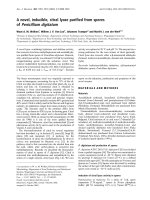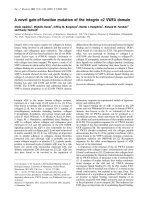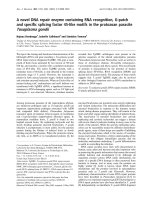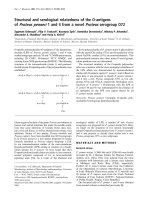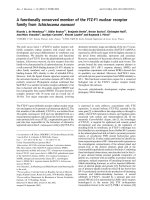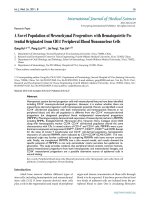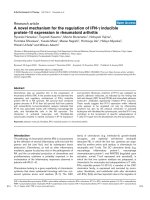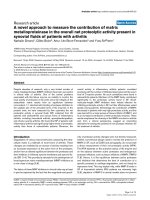Báo cáo Y học: A novel gain-of-function mutation of the integrin a2 VWFA domain docx
Bạn đang xem bản rút gọn của tài liệu. Xem và tải ngay bản đầy đủ của tài liệu tại đây (426.19 KB, 9 trang )
A novel gain-of-function mutation of the integrin a2 VWFA domain
Alexis Aquilina
1
, Michelle Korda
1
, Jeffrey M. Bergelson
2
, Martin J. Humphries
1
, Richard W. Farndale
3
and Danny Tuckwell
1
1
School of Biological Sciences, University of Manchester, Manchester, UK;
2
The Children’s Hospital of Philadelphia, Philadelphia,
PA, USA;
3
Department of Biochemistry, University of Cambridge, Cambridge, UK
Integrin a2b1 is the major r eceptor for collagens in human
tissues, being involved in cell adhesion and the control of
collagen and collagenase gene expression. The collagen
binding site of a2b1 h as been localized to the a2 von Wille-
brand Factor type A (VWFA) domain (A-domain or
I-domain) and the residues responsible for the interaction
with collagen have been mapped. We report a study of a2
VWFA domain in which residue E318, which lies outside the
collagen binding site, is mutated to tryptophan, showing that
this is a gain-of-function mutation. Recombinant a2-E3 18W
VWFA domain showed elevated and specific b inding to
collagen I compared with t he wild-type. Side chain hydro-
phobicity was important for the gain-of-function as elevated
binding was seen with E318I and E318Y, but not with
E318R. The E318W mutation had additional effects on
VWFA domain properties as a2-E318W V WFA domain
differed from the wild-type in its cation preferences for ligand
binding and in binding to monoclonal antibody JA203,
which bound at a site distal to E318. The gain-of-function
effect was not restricted to binding to collagen I as
a2-E318W also showed elevated binding to collagen IV,
collagen I C-propeptide, laminin and E-cadherin. Binding to
these ligands was i nhibited by collagen p eptide containing
the GFOGER motif, i ndicating that these bound to the
VWFA domain by a similar mechanism t o collagen I. These
data indicate that residue E318 plays a novel and important
role in mod ulating a2 VWFA domain–ligand b inding and
may b e involved in the conformational changes associated
with its regulation.
Keywords: adhesion; collagen; extracellular matrix; integrin.
Integrin a2b1 is the major human collagen receptor,
expressed on a wide range of cell types in vivo [1]. It has
been shown to m ediate cell adhesion in vitro to a range of
collagens [2–4], but is al so a r eceptor for a number of
noncollagenous molecules including laminins, collagen
C-propeptides, E-cadherin, and certain viruses a nd snake
toxins [5–10] (J. Whittard, A. P. Mould, A. Koch, O. Pertz,
J. Engel, M. J. Humphries, unpublished data). Binding o f
a2b1 to c ollagen induces collagen a nd collagenase gene
expression [11,12] and the initiation of the p 38 MAPK
signalling pathway [4]. a2b1 is also responsible for f orce
generation by cells in collage n gels [13] and may be involved
in matrix assembly [14,15]. In vivo, a2b1 plays an important
role in platelet adhesion to collagens during thrombus
formation [ 16], and a lthough a2b1 i s probably not the
major collagen receptor on platelets [17], a genetic predis-
position to increased levels of platelet a2b1maybearisk
factor for stroke [18], myocardial i nfarction [19], and
diabetic retinopathy [20] (although see [21,22]). a2b1has
also been found to be involved in the r egulation of
inflamatory responses in experimental models of hypersen-
sitivity and arthritis [23].
The ligand binding site of a2b1 is located in the 200
amino acid v on Willebrand Factor type A domain (VWFA
domain, also known a s the A- or I-domain) of t he a2
subunit. The a2 VWFA domain can be produced as a
recombinant protein, which reproduces the ligand specifi-
city, affinity and cation preferences of the complete molecule
[8,24–29]. The recognition sequence for a2 VWFA domain
on collagen I has been identified and contains an essential
GER sequence [ 30]. The determination of the structure of
a2 VWFA domain complexed with the c ollagen peptide
demonstrates that the E of the peptide coordinates with a
cation bound to the VWFA domain, forming a metal-ion-
dependent adhesion site (MIDAS) [31,32]. Recognition
sequences for the other noncollagenous ligands of a2b1
have yet to be determined.
Comparison of the structure of the a2 VWFA domain
complexed with collagen (ÔopenÕ conformation) and alone
(ÔclosedÕ conformation) [31,32] indicates that collagen bind-
ing is accompanied by important conformational changes in
the a2 VWFA domain, in particular in the C-terminal helix
a7. A number of studies ind icate that similar conforma-
tional changes in the aMandaL VWFA domains
accompany ligand binding [33–35]. In aM, residue F302,
which lies at the N -terminal end of helix a7, is buried in the
closed conformation, but exposed in the open form. The
substitution of a tryptophan at position F302 in aM led to
an increase in ligand binding, increased binding of an
antibody associated with aMb2 activation, and a n increase
in the proportion of active integrin [ 36]. This indicates that
F302 plays an important role in modulating ligand b inding,
Correspondence to D. Tuckwell, 2.205 Stopford Building, School of
Biological Sciences, University of Manchester, Oxford Road,
Manchester, M13 9PT, UK. Fax: + 44 161 275 5082,
Tel.: + 44 161 275 5061, E-mail: d
Abbreviations:GST,glutathioneS-transferase; MIDAS, metal ion-
dependent adhesion site; VWFA domain, von Willebrand factor type
A-domain.
(Received 1 7 September 2001, revised 26 November 2001, accepted
14 December 2001)
Eur. J. Biochem. 269, 1136–1144 (2002) Ó FEBS 2002
possibly by promoting the open conformation, although
this is debated [37].
Here we report an investigation into the function of the
residue corresponding to aM F302 in the a2 VWFA
domain, residue E318. Although E318 lies outside the
collagen binding site, introduction of the mutation E318W
resulted in increased ligand binding, changes in cation
preferences and altered antibody epitope expression. We
also e xamined the molecular basis for the gain-of-function
and exploited this property to study a2 VWFA domain
interactions with noncollagenous ligands of a2b1. These
data indicate that E318W has a similar effect on a2 as F302
does on aM and that residue E318 has an important role in
modulating a2 VWFA domain function.
MATERIALS AND METHODS
General reagents
Acid soluble rat tail type I c ollagen and EHS-laminin w ere
obtained from S igma-Aldrich. Collagen peptides were pre-
pared as described in [30]. Collagen IV fragment CB3 was the
kind gift of K. Ku
¨
hn, Max-Planck-Institute for Biochemist-
ry, Martinsreid, Germany [38]; collagen C-propeptide was
prepared as described in [ 7,8]; t he E- cadherin-COMP
construct comprising the five extracellular domains of mouse
E-cadherin fused to the assembly domain of rat cartilage
oligomeric matrix protein (COMP) was the kind gift of
J. Engel, Bı
´
ozentrum, University of Basel, Switze rland.
Mutagenesis and production of recombinant VWFA
domains
The generation of the wild-type a2 VWFA domain
construct has been described previously [26]. Mutagenesis
of this construct was carried out using the mutagenesis
protocols described by Kunkel [39] a nd the BIO-RAD
Muta-Gene mutagenesis kit. Essentially, single-stranded
uracil-containing DNA was generated by helper phage
infection o f Escherichia coli strainCJ236andthenusedas
the template for in vitro second-strand syntheses with the
following mutagenic oligonucleotides (bases differing from
the wild-type sequence are underlined): for E318 to W,
5¢-TTCAATGTGTCTGATTGGGCAGCTCTACTAGA
AAAGGCTG-3¢; for E318 to I, 5¢-CAATGTGTCTGA
TATAGCAGCTCTACTAGAAAAG-3¢; for E318 to R,
5¢-CAATGTGTCTGATCGAGCAGCTCTACTAGAAA
AG-3¢; for E318 to Y, 5¢-CAATGTGTCTGATTATGCA
GCTCTACTAGAAAAG-3¢. The resulting double-
stranded DNA was used to transfect E. coli strain DH5aF¢,
and single colonies containing the mutant DNA were
identified by DNA sequencing. Wild-type and mutant
recombinant VWFA domain–glutathione S-transferase
(GST) fusion proteins were produced and purified as
described previously [9,26,27].
Binding assays
Solid phase b inding assays to measure binding of biotiny-
lated collagen to a2 vWFA-domain were carried out as
follows: Immulon 4 microtitre plates (Dynex, B illinghurst,
West Sussex, UK) were coated with 100 lL a2 vWFA-
domain fusion proteins diluted in 136.8 m
M
NaCl, 8.1 m
M
Na
2
HPO
4
,2.7m
M
KCl, 1.5 m
M
KH
2
PO
4
,0.9m
M
CaCl
2
,
0.5 m
M
MgCl
2
, pH 7.4 (NaCl/P
i
+
wherethe+sign
indicates the presence of Mg and Ca ions) overnight at
4 °C. The following day, protein solutions were removed
and wells blocked with 200 lL50mgÆmL
)1
BSA,in40 m
M
Tris/HCl, 150 m
M
NaCl, pH 7.4 (NaCl/Tris), for 2 h at
room temperature. Wells were then washed three times
with 200 lL N aCl/Tris, 1 mgÆmL
)1
BSA, 1 m
M
MgCl
2
(bufferA),andtoeachwellwasthenadded50lL inhibitor
(in buffer A at double the final concentration) followed by
50 lL biotinylated collagen I (also in buffer A at double t he
final concentration), for 3 h at room temperature. Wells
were then washed three times with 200 lL buffer A and
100 lL 1 : 200 (v/v) ExtrAvidin-peroxidase (Sigma) in
buffer A added for 10 min at room temperature. Wells
were then washed three times with 200 lL buffer A, and
colour developed b y the addition of 2 m
M
2¢2¢-azino-bis-
(3-ethylbenzthiazoline-6-sulphonic acid), 0.03% (v/v) H
2
O
2
,
0.05
M
NaH
2
PO
4
,0.1
M
sodium acetate, pH 5.0 (ABTS
reagent). Absorbance was measured at 405 nm on a plate
reader. For experiments measuring collagen b inding in the
presence of different cation concentrations, the protocol was
carried out as above up to the blocking stage, then wells
were washed three times with 200 lL NaCl/Tris,
1mgÆmL
)1
BSA, then 50 lLcation(inNaCl/Tris,
1mgÆmL
)1
BSA at double the final concentration) was
added followed by 50 lL b iotinylated c ollagen I (also i n
NaCl/Tris, 1 mgÆmL
)1
BSA at double the final concentra-
tion). All subsequent steps were as above.
For the measurement o f VWFA domain binding to
immobilized collagen I, collagen IV CB3, C-propeptide,
laminin, E-cadherin or polylysine, Immulon 4 microtitre
plates (Dynex) were coated with 100 lL c ollagen I or other
ligands diluted in NaCl/P
i
+
overnight at 4 °C. The follow-
ing day, protein solutions were removed and wells blocked
as above. We lls were then washed three times with buffer A,
andtoeachwellwasadded50lL inhibitor (in buffer A at
double t he final concentration) followed by 50 lL VWFA
domain (also in buffer A at double the final concentration),
for 3 h at room temperature. Wells were then washed three
timeswith200lLbufferAand100lL sheep anti-GST
antiserum ( the kind gift of V. A llan and S. Taylor, Univer-
sity of Manchester, UK) 10 lgÆmL
)1
in buffer A added f or
1 h at room temperature. Wells were then washed thre e
times with 200 lL buffer A and 100 lL peroxidase
antisheep (DAKO), 1 : 1000 (v/v) in buffer A added for
1 h at room temperature. Wells were then washed thre e
times with 200 lL buffer A, and colour developed by the
addition of ABTS reagent as above. For assays measuring
the binding of VWFA domain to collagen in the presence of
increasing cation concentrations, NaCl/Tris was cleared of
residual cations by the addition of % 1gÆL
)1
Chelex 100
overnight a nd the Chelex removed by filtration p rior to use
in assays. The assay protocol was carried out as above up to
the b locking s tage, then wells were washed three times with
200 lL N aCl/Tris, 1 mgÆmL
)1
BSA, and 50 lLcation(in
NaCl/Tris, 1 mgÆmL
)1
BSA at double the final concentra-
tion) was a dded followed b y 50 lL VWFA domain (also in
NaCl/Tris, 1 mgÆmL
)1
BSA at double the final concentra-
tion). All subsequent steps were as above with the exception
that buffer A contained 1 m
M
MgCl
2
and 1 m
M
MnCl
2
.
Assays to measure antibody binding to recombinant
VWFA domains w ere carried out after the method of
Ó FEBS 2002 Integrin a2 gain-of-function mutation (Eur. J. Biochem. 269) 1137
Brookman et al. [40]. Immulon 4 microtitre plates were
coated with 100 lL5lgÆmL
)1
fusion protein in NaCl/P
i
+
,
overnight at 4 °C. Wells were the n washed twice with
200 lLNaCl/P
i
–
(NaCl/P
i
+
without Ca
2+
or Mg
2+
)and
blocked with 100 lL 2% (w/v) fat-free milk powder, NaCl/
P
i
–
,for1hat4°C. Wells were then washed twice with
200 lL 0.1% (v/v) Tween 20, NaCl/P
i
–
,and100lL
antibody diluted in 0.5% ( w/v) milk powder, 0.1% (v/v)
Tween 20, NaCl/P
i
–
, added for 2 h at 4 °C. Wells were then
washed twice with 200 lL 0.1% (v/v) Tween 20, NaCl/P
i
–
,
and peroxidase antimouse (for mouse monoclonals;
DAKO) or peroxidase antisheep (for sheep anti-GST)
diluted in 0 .5% (w/v) milk powder, 0.1% (v/v) T ween 20,
NaCl/P
i
–
, added for 2 h at 4 °C. Wells were then washed
three times with 200 lL 0.1% (v/v) Tween 20, NaCl/P
i
–
,and
colour developed by the addition of ABTS reagent as above.
RESULTS
The E318W mutation in a2 increases collagen binding
The introduction of the mutation F302W into aM has been
showntoresultinagainoffunctioninboththeisolatedaM
VWFA domain and in aMb2 [36]. Comparison of the a2
and aM sequences and structures indicated that the
homologous residue in a2isE318(Fig.1A),aresiduein
the a7 helix which, like aM F302, undergoes a large
displacement on collagen binding and moves fro m a buried
to an exposed position (Fig. 1B and C). a2E318was
therefore mutated to tryptophan, the recombinant mutant
VWFA domain gen erated, and t he a2 E318W VWFA
domain tested in solid phase binding assays. a2-E318W
VWFA domain showed enhanced binding to collagen I
compared with w ild-type VWFA domain, both w hen
binding of biotinylate d collagen to i mmobilized VWFA
domain (Fig. 2A) and binding of VWFA domain to
immobilized collagen was measured (Fig. 2B). The inter-
action of a2-E318W VWFA domain with collagen was
specific as it could be inhibited by EDTA (Fig. 2 A and B) as
well as by a collagen peptide containing the a2 recognition
sequence GFOGER (Fig. 2C). The data from the binding
of biotinylated collagen t o VWFA domains were a nalysed
by curve fitting a nd double reciprocal plots (analyses were
carried out on the results of four independent experiments):
the apparent affinities for the wild-type and mutant V WFA
domains were 3 .3 lgÆmL
)1
and 0.5 lgÆmL
)1
, respectively,
and the binding of wild-type VWFA domain, which is not
saturated over the range shown in Fig. 2 A, was calculated
to reach 82% of the level of a2 E318W VWFA domain.
E318W therefore results in elevated collagen binding
primarily by altering the apparent affinity of the VWFA
domain–collagen interaction, although residue 318 does not
form part of the collagen b inding site (MIDAS). This
increase in binding was not due t o misfolding or d ifferences
in stability of t he VWFA domain as the previously
characterized monoclonal antibodies JA202, JA208,
JA215, JA218 and Gi9 [9] showed identical levels of binding
to wild-type and mutant VWFA do main (data not shown).
To determine the molecular basis of the effect of the
E318W mutation, E318 was mutated to Y, I a nd R and
recombinant VWFA domains tested: a2-E318Y and
a2-E318I behaved similarly to a2-E318 W, while a2-E318R
showed reduced binding to collagen I compared with wild-
type (Fig. 3). Thus a hydrophobic residue at position E318 is
required for the enhanced collagen I b inding, but the size of
the r esidue is less important. The decreased b inding of
Fig. 1. E318 moves between the ‘open’ and ‘closed’ forms of a2 VWFA domain. (A) Alignment of C-terminal seq uence of a2andaMVWFA
domains sh owing a2E318andaM F302 (boxed). Secondary structural elements are marked above the alignment; dots indicate residues identical
between a2andaM. (B, C) Structure of the C-terminal region of a2 VWFA domain, in the presence (B) or absence (C) of collagen p eptide ligated.
The arrow indicates t he position of the E318 side chain, which is altered by the conformational change.
1138 A. Aquilina et al. ( Eur. J. Biochem. 269) Ó FEBS 2002
E318R relative to wild-type is likely to be due to effects on
global conformation, as this mutant was unstable and its
activity decreased over t he course of a few days.
The E318W mutation affects the MIDAS and helix a3
The interac tion of c ollagens with the a2 VWFA domain
requires the MIDAS c ation and we have previously shown
that either Mg
2+
or Mn
2+
will support VWFA domain–
collagen binding [9,26]. The effects of the E318W mutation
on the requirements for cations in collagen binding were
therefore investigated. The wild-type and mutant VWFA
domains showed similar curves f or binding of biotinylated
collagen i n t he presence of Mg
2+
but differed in their
binding in the p resence of Mn
2+
,withthea2-E318W
VWFA binding curve shifted to the left compared w ith the
wild-type, which displayed a complex profile ( Fig. 4A
and B). Similar profiles for a2-E318W and wild-type w ere
seen over a range of cation and fusion protein concentra-
tions (data not shown). A ssays in which t he immobilized
and soluble components were swapped (measuring the
binding of VWFA domain to collagen-coated plates) also
gave very similar profiles (Fig. 4C,D). The a2-E318W
mutation therefore affects t he formation of t he collagen–
cation–VWFA domain complex at the MIDAS, l eading to
altered cation preferences compared with wild-type. This is
despite the mutation being topologically distinct from the
MIDAS itself.
In order to identify other regions which might be affected
by the E318W mutation, the panel of 21 anti-VWFA
domain monoclonal antibodies, JA201–JA221 previously
developed by us [9] was s creened for differential binding to
a2-E318W VWFA domain compared with wild-type.
Antibody JA203 was found to bind with a lower affinity
to a2-E318W VWFA domain than to wild-type (Fig. 5A).
Other antibodies bo und to the w ild-type and mutant
domains at s imilar levels (data f or JA202 is shown f or
comparison in Fig. 5B). The epitope for JA203 was mapped
using human–mouse chimeras which spanned the full extent
of the VWFA domain [41]. This approach exploits the fact
Fig. 2. a2-E318W shows elevated specific binding to collagen compared
with wild-type. (A) Microtitre p lates were c oated with 10 lgÆmL
)1
a2-E318W (n,m) or wild-type a2(h,j) and the binding of bio tinyated
collagen I measured in the presence of 1 m
M
MgCl
2
(m,j)or1m
M
MgCl
2
/10 m
M
EDTA (n,h). Data are means ± SD; n ¼ 4fromtwo
experiments. (B) Microtitre plates were coated with 1 lgÆmL
)1
colla-
gen I and binding of a2-E318W or wild-type a2(2lgÆmL
)1
)measured
in the p resence of 1 m
M
MgCl
2
(dark bars) or 1 m
M
MgCl
2
/10 m
M
EDTA (light bars). Data are means ± SD; n ¼ 7 from three experi-
ments (wild-type) and n ¼ 5 from t wo experiments (a2-E318W).
(C) Microtitre plates were c oated with 1 lgÆmL
)1
collagen I and the
binding of 0.5 lgÆmL
)1
a2-E318W measured in the presence of 1 m
M
MgCl
2
with the ad dition of 100 lgÆmL
)1
GFOGER collagen peptide
(which carries the a2 binding site), or co ntrol collagen peptide (which
does not carry the a2 binding site).
Fig. 3. a2E318I and a2 E318Y show enhanced collagen I binding.
Binding of biotinylated collagen I to a2-E318 mutatio ns E318W (r),
E318I (m) E 318Y (d)andE318R(s) is shown. Binding to wild-type
(j) and wild-type + EDTA (h) are shown for comparison. Microtitre
plates were coated with 10 lgÆmL
)1
VWFA domains and the binding
of biotinylated collagen I measured. Binding of mutants in the pres-
ence of EDTA was the same as that seen for wild-type + EDTA. Data
are means ± SD; n ¼ 6 from t hree experiments except for E318R
where n ¼ 4 from two experiments.
Ó FEBS 2002 Integrin a2 gain-of-function mutation (Eur. J. Biochem. 269) 1139
that JA203 was raised i n mouse against a human antigen,
and will therefore bind t o residues differing between human
and mouse a2 VWFA domain. The binding of JA203 to
eight of the nine chimeras was similar to that of wild-type
VWFA domain, but no binding to the chimera covering
helix a3 was seen (Fig. 6 ). The E318W mutation t herefore
affects helix a3. Significantly, we have previously identified
this region as the binding site for other functionally relevant
antibodies [9]. The helix a3 region is t opologically distinct
from residue E318 and there is a number of chimeras which
alter amino acids located between E318 and he lix a3withno
effect on JA203 binding. The differential binding of JA203 is
therefore not due to a mutation within its epitope. The
cation binding and the JA203 d ata indicate that the E318W
mutation has specific effects on VWFA domain properties
in addition to collagen binding. Because the sites affected
are topologically distinct from the site of the mutation, these
effects m ay be due to conformational changes which are
transmitted to the MIDAS and the JA203 epitope.
The consequences of the E318W mutation for a2 function
a2b1 is a recep tor not only for collage n I but also for
collagen I V, collagen I C-propeptide, laminin a nd E-cad-
herin [5,7–9,38], and so the effect of the E318W mutation on
the interaction of the a2 VWFA domain with other ligands
was investigated. a2-E318W VWFA domain showed
elevated specific binding to the integrin-binding CB3
fragment of collagen IV and to all three noncollagen
proteins ( Fig. 7A). No similar i ncrease i n binding to the
control p roteins, fibrinogen or the 50 k Da fragmen t of
fibronectin was seen. This indicated t hat the enhancing
effect of the E318W mutation was not confined to collagens
alone. Little i s known about the molecular basis of a2
VWFA domain binding to its noncollagenous ligands and
the binding of wild-type a2 VWFA domain to laminin and
E-cadherin is typically much lower than to collagen I.
However, the elevated binding seen with a2-E318W allowed
us to study these otherwise weak interactions. Binding of
Fig. 4. a2-E318W and wild-type a2 differ in their cation preferences for binding to collagen I. (A, B) Microtitre plates were coated with 0.2 lgÆmL
)1
a2-E318W (A) or 0.5 lgÆmL
)1
wild-type a2 (B) and the binding of 1 lgÆmL
)1
biotinylated collagen I measured in the presence of Mn
2+
(d), Mg
2+
(m), or EDTA (e). (C, D) Micro titre plates were coated with collagen I (1 lgÆmL
)1
)anda2-E318W (C) or wild-type a2(D)addedat1lgÆmL
)1
in
the presence of M n
2+
(d)orMg
2+
(m) and detected with anti-GST Ig. Data are means ± range (n ¼ 2) from representative experiments.
Fig. 5. JA203 shows differential binding to a2-E318W compared with
wild-type a2. (A) JA203 binds with lower affinity to a2-E318 W (s)
than to wild-type a2 VWFA domain (d); (B) B inding of JA202 is
identical for a2-E318W ( s) and wild-type (d), and is shown for
comparison. Microtitre plates were coated with 5 lgÆmL
)1
VWFA
domain and the bin ding of antibodies measured over a range of con-
centrations. Data a re means±SD; n ¼ 6 from two experiments.
1140 A. Aquilina et al. ( Eur. J. Biochem. 269) Ó FEBS 2002
a2-E318W to collagen IV C B3, C-propeptide, laminin and
E-cadherin was inh ibited by EDTA (Fig. 7A) and collagen
peptide ( Fig. 7B). Binding of a2-E318W to polylysine was
not inhibited. These inhibitor studies showed that binding of
these ligands to a2 VWFA domain occurs at the same site as
collagen I and probably by the same mechanism.
DISCUSSION
We report a novel gain-of-function mutation o f the a2
VWFA domain. I ntroduction of the E318W mutation led
to increased specific collagen binding as well as alterations in
cation preferences for collagen binding and in the binding of
antibody JA203. These data suggested t hat the mutation
exerted its effect by inducing conformational changes in the
VWFA domain. We a lso describe f urther mutations of
E318 which help to define the molecular basis of the gain-of-
function effect as well as fu nctional studies showing that
noncollagenous a2b1 ligands bind to the mutant VWFA
domain at an elevated level relative to wild-type a nd by the
same mech anism a s c ollagen I. The E318W mutation in a2
therefore has a similar effect as the equivalent mutation
F302W in the aM VWFA domain, which also showed
increased binding [36].
The molecular basis of the interaction between a2 VWFA
domain and collagen I is now well understood following the
solution of the X-ray crystal structure of the VWFA
domain–collagen c ocrystal [32]. This interaction involves a
discrete set of residues clustering round the cation binding
site, as well as the cation itself. It is o f interest t hat the
E318W mutation has such a large effect on the binding of
collagenous and non collagenous ligands but does not form
part of the ligand binding site. In addition to the effects on
ligand binding, the mutation also affected the use of cations
by the ligand binding site. Although the precise nature of
the atomic events responsible for the shifts between
preferences for Mg
2+
and M n
2+
are n ot clear, change s in
Fig. 6. The epitope for JA203 is located in the a3 helix. The JA203 epitope was mapped using human -mouse a2 VWFA domain chimeras [41]. The
figure shows the mutations introduced to convert stretches of human to mouse sequence; the percentage binding of JA203, compared with wild-type
a2; and a diagrammatic representation of the a2 VWFA domain s equence indicating the location of the mutations. The percent b inding for the
chimera in which JA203 binding was abolished is given in bold, and the a3 helix in which it located is shaded. The site of the E318W mutation is
shown with an asterisk. Binding to human wild-type a2, 100 ± 1.9%; binding to mouse wild-type a2, )0.8 ± 0.3%. Microtitre plates were coated
with 5 lgÆmL
)1
wild-type or chimeric VWFA domain and the binding of antibody JA203 measured. Binding of anti-GST antiserum to constructs
was used t o normalize the data between VWFA domains. Data are means ± SD, n ¼ 4 from t wo experiments.
Fig. 7. a2-E318W shows elevated and specific binding to collagen IV
(CB3 fragment), collagen I C-propeptide, laminin and E-cadherin.
(A) a2-E318W shows elevated binding to a2b1 ligands compared with
wild-type VWFA domain. Microtitre plat es were coated with ligands
and the binding o f a2-E318W (grey bars, white b ars) and w ild-type
(black bars, hatched bars) was measured in the presence of 1 m
M
MgCl
2
(grey bars, black bars) or 1 m
M
MgCl
2
/10 m
M
EDTA (white
bars, hatched bars). Data are means ± SD; n ‡ 6 from at least three
experiments. (B) Binding of a2-E318W to a2b1 ligands is specific.
Uninhibited binding (black bars); binding in the presence of the
inhibitory peptide GFOGER (grey bars); binding in the presence of the
control co llagen peptide (white bars). Data are means ± SD; n ¼ 4
from two experiments. Microtitre plates were coated with proteins
(Collagen IV CB3 fragment, 3 lgÆmL
)1
; collagen I C-propeptide,
10 lgÆmL
)1
; laminin, 2 0 lgÆmL
)1
;E-cadherin-COMP,10lgÆmL
)1
;
50 kDa fragment of fibronectin, 10 lgÆmL
)1
; fibrinogen, 10 lgÆmL
)1
)
and the binding of 0.5 lgÆmL
)1
fusion protein measured.
Ó FEBS 2002 Integrin a2 gain-of-function mutation (Eur. J. Biochem. 269) 1141
the conformation of the cation coordinating residues seem
likely. These data suggest that there is a general alteration in
the structure or environment of the ligand binding site as a
result of the E318W mutation, affecting the way i n which
the t ertiary complex of VWFA domain, c ation and ligand
are formed. This was accomplished without any a lteration
in the specificity of t he interaction. The differential binding
of antibody JA203 to a2 E318W compared with wild-type
clearly identified this region as un dergoing conformational
changes as a result of the mutation. It is likely that this is due
to alterations at the MIDAS, as t he C-terminal region of the
JA203 epitope falls within the ligand binding site. These
changes in the MIDAS are likely to be quite subtle, as
antibodies JA202, JA208 and Gi9 map to this region [9], but
their binding was unchanged. We previously showed that
the helix a3 region is very sen sitive to events at the MIDAS,
as binding of JA208 is enhanced by collagen I, indicating an
interplay between the MIDAS and the JA208 epitope [9],
while JA202 and Gi9 inhibited ligand b inding. The JA203
data further d emonstrate t he importance o f the helix a3
region in a2 V WFA domain function. The E318W muta-
tion therefore h as significant effects o n VWFA domain
function, particularly o n t he MIDAS. However, the fact
that E318 is spatially diatant from the MIDAS/JA203
epitope indicates that these effects do not occur t hrough a
direct contribution of E318 to the MIDAS. We therefore
propose t hat E318W functions by affecting the conforma-
tion of the VWFA d omain. This would be a highly specific
effect, since the global conformation of the domain is
unaffected, as shown by unaltered binding of a range of
antibodies to the mutant domain compared to t he wild-
type.
Residue E318 differs substantially in its position between
the open and closed forms of a2. A number of recent reports
have shown t hat the ligand binding function of the aLand
aM VWFA domains can be modulated by controlling the
conformational state o f the domain. The majo rity of
approaches have directly targeted the a7 helix, because of
the large difference in conformation between the two forms,
with the aim of stabilizing the open or closed forms
[35,36,42–44]. Our report indicates that the general
approach of targeting a residue which undergoes a confor-
mational change b etween the open a nd closed forms can
also result in a gain of function in a2. This is t he first report
of a deliberate engineering strategy being u sed for a2and
since t he E318 is conserved in a1, a10 and a11, the gain-of-
function property seen here should be reproducible in these
other integrins.
To account for the molecular events resulting from the
F302W mutation [36], it was suggested that the increased
bulk of the tryptophan side chain drove residue 302 from its
buried location in the closed form, to the solvent-exposed
location seen in the open form, thus promoting the open
form of the whole domain [36]. Residue E318 in a2VWFA
domain is, like aM F302, buried in the closed f orm and
exposed in the open form, but our data indicate that the side
chain bulk is not important in the gain-of-function effect.
However, the side chain of E318 forms a hydrogen bond
with R288 in the closed form, and this bond is brok en on
moving to the open form. The loss of the hydrogen bond in
the E318I/Y/W mutations, coupled with the hydrophobic
character of the mutation, may facilitate conformational
changes in the domain, for example by lowering t he energy
barrier separating the two forms and thus promoting the
open state.
a2-E318 VWFA domain showed increased binding to
collagen I C-propeptide, laminin an d E-cadherin, compared
with wild-type a2, indicating that the mutation also affected
binding to these noncollagenous ligands. The interactions
with laminin and E-cadherin are normally very weak and in
consequence hard to study. However, the elevated binding
seen with the mutant made possible i nhibition studies and
we could show that the interaction of the a2 VWFA domain
with these p roteins could b e inhibited by the GFOGER
collagen peptide. The residues responsible for the interac-
tion of these proteins with th e a2 VWFA domain have yet
to be identified, but our data su ggest that glutamate residues
are good c andidates for the key cation-coordinating
residues. E31 of E-cadherin i s known to be responsible for
binding to aEb7 [ 45] and so this residue may also be central
to the interaction of E-cadherin with the a2 VWFA domain.
The availability of the a2-E318W mutant will greatly
facilitate the mapping of the integrin binding sites on
collagen C-propeptide, laminin and E-cadherin and will also
be a useful tool for the development of potent a2b1
antagonists.
In conclusion, we have generated a mutant form of the a2
VWFA domain which shows a gain-of-function, and which
may result in the promotion of the open form. He lix a7is
therefore seen to b e a valid target for such mutations across
the integrin family. This mutation will be of considerable
value for future studies of the role of a2b1 at both the
molecular and cellular level.
ACKNOWLEDGEMENTS
D. T. is su pported by a Biotechnology and B iological Sciences
Research Council Advanced Research Fellowship (34/AF09035);
M. J. H. is a W ellcome Trust Principal Fellow; R. W. F. is supported
by the Medical Research Council. The authors a re grateful to
M. Brannan, S. Craig and L. Smith for advice and a ssistance.
REFERENCES
1. Zutter, M.M. & S antoro, S .A. ( 1990) Widespread histologic dis-
tribution of the alpha 2 beta 1 integrin cell-surface collagen
receptor. Am. J. Pathol. 137, 113–120.
2. Tuckwell, D.S. & Humphries, M.J. (1996) Integrin-collagen
binding. Seminars Cell Dev Biol. 7 , 649–657.
3. Dickeson, S.K. & Santoro, S.A. (1998) Ligand recognition by I
domain-containing integrins. Cell. M ol. Life Sci. 54, 556–566.
4. Heino, J. (2000) The collagen receptor integrins have distinct
ligand recognition and s ignaling functions. Ma trix Bi ol. 19,
319–323.
5. Elices, M .J. & Hemler, M.E. (1989) The human integrin VLA-2 is
a collagen receptor on some cells and a collagen/laminin receptor
on others. Proc. Natl Acad. Sci. USA 86, 9906–9910.
6. Bergelson, J.M., Shepley, M.P., Chan, B .M.C., Hemler, M.E. &
Finberg, R.W. (1 992) Identification of the integrin VLA-2 as a
receptor for echovirus 1. Science 255, 1718–1720.
7. Weston, S.A., Hulmes, D .J.S., Mould, A.P., Watson, R .B. &
Humphries, M.J. (1994) Identification of the integrin a2b1asacell
surface receptor for the C-prop eptide of type I procollagen. J. Biol.
Chem. 269, 20982–20986.
8. Davies, D., Tuckwell, D.S., Calderwood, D. A., Weston, S .A.,
Takigawa, M . & Humphries, M.J. (1997) M olecular characteri-
sation of integrin-procollagen C-propeptide interactions. Eur. J.
Biochem. 246, 274–282.
1142 A. Aquilina et al. ( Eur. J. Biochem. 269) Ó FEBS 2002
9. Tuckwell, D.S., Smith, L.C., Korda, M., Askari, J.A., Santoso, S.,
Barnes, M., Farndale, R.W. & Humphries, M.J. (2000) Mono-
clonal antibodies i dentify residues 1 99–216 of the integrin a2
vWFA domain as a functionally important region w ithin a2b1.
Biochem. J. 350 , 485–493.
10. Eble, J.A., Beermann, B., Hinz, H J. & Schmidt-Hederich, A.
(2001) a2b1 integrin is not recognized by rhodocytin, but is the
specific, high-affi nity target o f rh odocetin, an RG D-in dependent
disintegrin and potent inhibitor of cell adhesion to collagen.
J. Biol. C hem. 276, 12274–12284.
11. Langholz, O., Rock el, D., Mauch , C., Kozlo wska , E., Ban k, I.,
Krieg, T. & Eckes, B. (1995) Collagen and collagenase gene
expression in three-dimensional collagen lattices are differentially
regulated by a1b1anda2b1 integrins. J. Cell Biol. 131, 1903–1915.
12. Riikonen, T., Westermarck, J., Koivisto, L., Broberg, A., Kahari,
V M. & Heino, J . (1995) Integrin a2b1 is a positive regulator of
collagenase (MMP-1) and collagen a1 (I) gene expression. J. Biol.
Chem. 270, 13548–13552.
13. Jenkins, G., Redwood, K.L., Meadows, L. & Green, M.R. (1999)
Effect of gel re-organization and tensional forces on a2b1integrin
levels in dermal fibroblasts. Eur. J. Biochem. 263, 93–103.
14. Fleischmajer, R., P erlish, J.S., MacDonald, D., Schechter, A.,
Murdoch, A., Iozzo, R.V. & Yamada, Y. (1998) There is binding
of collagen IV to b1integrinduringearlyskinbasementmem-
brane assembly. Ann. NY Acad. Sci. 857, 212–227.
15. Schiro, J.A., Chan, B.M.C., Roswit, W.T., Kassner, P.D., Pen-
tland, A., Hemler, M.E., Eisen, A.Z. & Kupper, T.S. ( 1991)
Integrin a2b1 (VLA-2) mediates reorganization and contraction of
collagen matrices by h uman cells. Cell 67 , 403–410.
16. Nieuwenhuis, H.K., Akkerman, J.W.N., Houdijk, W.P.M. &
Sixma, J.J. (1985) H uman blood plate lets s h owing no response
to collagen fail to express surface glycoprotein Ia. Nature 318,
470–472.
17. Nieswandt, B., Brakebusch, C., Bergmeier, W., Schulte, V.,
Bouvard, D., Mokhtari-N ejad, R., Lin dhout, T ., Heemskerk ,
J.W.M., Zinngibl, H. & Fa
¨
ssler, R. (2001) G lycoprotein VI but
not a2b1 integrin is essential for platelet int eraction with collagen.
EMBO J. 9, 2120–2130.
18. Carlsson, L.E., Santoso, S., Spitzer, C., Kessler, C. & Greinacher,
A. (1999) The a2 gene coding sequence T807/A873 of the platelet
collagen receptor integrin a2b1 might be a genetic risk factor
for t he development of stroke in younger patients. Blood 93,
3583–3586.
19. Moshfegh, K., Wuillemin, W.A., Redondo, M., La
¨
mmle, B., Beer,
J.H., L iechti-Gallati, S . & Meyer, B.J. (1999) Association o f two
silent polymorphisms of platelet glycoprotein Ia/Iia receptor with
risk of myocardial infarction : a case con trol study. Lancet 353,
351–353.
20. Matsubara, Y., Mur ata, M., Maruyama, T., Handa, M.,
Yamagata, N ., Watanabe, G ., Saruta, T. & Ikeda, Y. (2000)
Association between diabetic retin opathy and genetic variation s
in a2b1 i ntegrin, a p latelet receptor for collagen. Blood 95 ,
1560–1564.
21. Carlsson, L.E., Greinacher, A., Spitzer, C., Walther, R. & Kessler,
C. (1997) Polymoprhisms of the human platelet a ntigens HPA-1,
HPA-2, HPA-3 and HPA-5 on the platelet receptors for fibrinogen
(GPIIb/IIIa), von Willebrand factor (GPIb/IX), and collagen
(GPIa/Iia) are not correlated with an increased risk for stroke.
Stroke 28, 1392–1395.
22. Croft, S.A., Hampton, K.K., Sorrell, J.A., Steeds, R.P., Channer,
K.S., Samani, N.J . & Daly, M.E. (199 9) The GPIa C807T
dimorphism asso ciated with p latelet collagen receptor density is
not a risk factor for myocardial infarction. Br. J. Haematol. 106,
771–776.
23. de Fougerolles, A., Sprague, A., Nickerson-Nutter, C.L.,
Chi-Rosso, G., Rennert, P.D., Gardner, H., Gotwals, P .J., Lobb,
R.R. & Koteliansky, V.E. (2000) Regulation of inflamation by
collagen-binding integrins a1b1anda2b1inmodelsofhypersen-
sitivity and a rthritis. J. Clin. Invest. 105, 721–729.
24. Kamata, T. & Takada, Y. (1994) Direct binding of collagen to the
I-domain of a2b1 (VLA-2, CD49b/CD29) in a divalent cation-
independent manner. J. Biol. Chem. 269, 26006–26010.
25. King, S.L ., Cunningham, J.A., Finberg, R.W. & Bergelson, J.M.
(1995) Echovirus 1 interaction with the isolated VLA-2 I domain.
J. Virol. 69 , 3237–3239.
26. Tuckwell, D.S., Calderwood, D.A., Green, L.J. & Humphries,
M.J. (1995) Integrin a2, I- domain is a binding site fo r collagens.
J. Cell Sci. 108, 1629–1637.
27. Tuckwell, D.S., Reid, K.B.M., Barnes, M.J. & Hu mphries, M.J.
(1996) Integrin a2 A-domain binds specifically to a range of col-
lagens but is not a general receptor for the collagenous motif. Eur.
J. Biochem. 24 1 , 732–739.
28. Calderwood, D.A., Tuckwell, D.S., Eble, J.A., Ku
¨
hn, K. &
Humphries, M.J. (1997) The integrin a1 A-domain is a ligand
binding s ite for coll agens and laminin. J. Biol. C hem. 272,
12311–12317.
29. Depraetere, H., Wille, C., Gansemans, Y., Stanssens, P., Lauw-
ereys, M., Baruch, D., De Reys, S. & Deckmyn, H. (1997) The
integrin a2b1 (GPIa/IIa)-I-d omain i nhibits p latelet–collagen
interaction. Thrombosis Haemostasis 77 , 981–985.
30. Knight, C.G., Morton, L.F., Onley, D.J., Pe achey, A.R.,
Messent, A.J., Smethurst, P.A., Tuckwell, D.S., Farndale, R.W. &
Barnes, M.J. (1998) Identification in collagen type I of an integrin
a2b1-binding site containing an essential GER sequence.
J. Biol. Chem. 273, 33287–33294.
31. Emsley, J., King, S.L., Bergelson, J.M. & Liddington, R.C. (1997)
Crystal structure of the I-domain from from integrin a2b1. J. Biol.
Chem. 272, 28512–28517.
32. Emsley, J., K night, C.G., Farndale, R.W., Barnes, M.J. &
Liddington, R.C. (2000) Structural basis of collagen recognition
by integrin a2b1. Cell 10 0 , 47–56.
33. Lee, J O., Bankston, L.A., Arnaout, M.A. & L iddington, R.C.
(1995) Two c onformations of the integrin A-domain (I-domain):
a pathway for a ctivation? Structure 3, 1333–1340.
34. Lee, J O., Rieu, P., Arnaout, M.A. & L iddington, R.C. (1995)
Crystal structure of the A-domain from the a subunit of integrin
CR3 (CD11b/CD18). Cell 80, 631–638.
35. Huth, J.R., Olejniczak, E.T., Mendoza, R., Liang, H., Harris,
E.A.S., Lupher, M.L., Wilson, A.E., Fesik, S.W. & Staunton,
D.E. (2000) NMR and mutagenesis evidence for an I d omain
allosteric site that regulates lymphocyte f unction-associat ed
antigen 1 ligand binding. Proc. Natl Acad. Sci. USA 97,
5231–5236.
36. Li, R., Rieu, P., Griffith, D., Scott, D. & Arnaout, A. (1998) Two
functional states of the CD11b A-domain: C orrelations with key
features of two M n
2+
-complexed crystal structures. J. Cell Biol.
143, 1523–1534.
37. Shimaoka, M., Shifman, J.M., Jing, H., Takagi, J., Mayo, S.L. &
Springer, T.A. (2000) Computational design of an integrin I
domain stabilized in the open high affinity conformation. Nat.
Struct. Biol. 78, 674–678.
38. Vandenberg, P., Kern, A., Ries, A., Luckenbill-Edds, L., M ann,
K. & Ku
¨
hn, K. (1991) Characterization of a type IV collagen
major cell binding site with affinity to the a1b1andthea2b1
integrins. J. Cell Biol. 113, 1 475–1483.
39. Kunkel. T.A. (1985) Rapid and efficient site-specific mutagenesis
without phenotypic selection. Proc. Natl Acad. Sci. 82, 488–492.
40. Brookman, J.L., Stott, A.J., C heeseman, P.J., Burns, N.R.,
Adams, S.E., Kingsman, A.J. & Gull, K. (1995) An immuno-
logical analysis of t he Ty virus-like particle. Virology 207, 59–67.
41. King, S.L., Kamata, T., C unningham, J.A., Emsley, J., Lidding-
ton, R.C., Takada, Y . & Bergelson, J.M. (1997) Echovirus 1
interaction with the human Very Late Antigen-2 (integrin a2b1), I
Domain. J. Biol. Chem. 272, 28518–28522.
Ó FEBS 2002 Integrin a2 gain-of-function mutation (Eur. J. Biochem. 269) 1143
42. Xiong, J P., Li, R., Essafi, M., Stehle, T. & Arnaout, M.A. (2000)
An isoleucine-based allosteric switch controls affinity and
shape shifting in integrin CD11b A-domain. J. Biol. C he m. 27 5 ,
38762–38767.
43. Lu, C., Shimaoka, M., Ferzly, M., Oxvig, C., Takagi, J. &
Springer, T. (2001) An isolated, surface-expressed I domain of the
integr i n aLb2 is sufficient for strong adhesive function when
locked in th e open conformation with a disulphide bond. Proc.
Natl Acad. S ci. USA 98, 2387–2392.
44. Lu, C., Shimaoka, M., Zang, Q., Takagi, J. & Springer, T. (2001)
Locking in alternative c onform ations of t he integrin aLb2, I
domain with disulphide bo nd s r eveals functional relationships
among i ntegrin domains. Proc. Natl A cad. Sci. USA 98, 2393–
2398.
45. Karecla, P.I., Green, S.J., Bowden, S.J., C oadwell, J. & Kilshaw,
P.J. (1996) Identification o f a binding site for integrin aEb7in
the N-terminal domain of E-cadherin. J. Biol. Chem. 271,
30909–30915.
1144 A. Aquilina et al. ( Eur. J. Biochem. 269) Ó FEBS 2002

